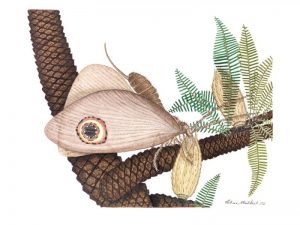
Large butterfly-like insects known as Kalligrammatid lacewings, which fluttered through Eurasian fern- and cycad-filled woodland during the Mesozoic Era, have been extinct for more than 120 million years. But with new fossil analyses, scientists at the Smithsonian’s National Museum of Natural History have discovered that these ancient lacewings were surprisingly similar to modern butterflies, which did not appear on Earth for another 50 million years.
Through taxonomic, anatomical and geochemical studies, scientists led by Smithsonian paleoecologist Conrad Labandeira revealed that Kalligrammatid lacewings likely served as important pollinators during mid-Mesozoic times, using mouthparts that were strikingly similar to the elongated, tubular structures that modern butterflies have to sip nectar-like fluids from flowering plants. What’s more, their wings bore eyespot patterns that closely resemble those found on some butterflies today, which may have helped to distract or deter potential predators.
Labandeira and his colleagues–an international team of geochemists, botanists, entomologists and paleobiologists–reported their findings Feb. 3, in the journal Proceedings of the Royal Society B. Their findings represent a striking example of convergent evolution between these two unrelated lineages, in which the two distinct groups of organisms evolve similar traits as they interact to similar features in their environments.
Paleobiologists have known for more than 100 years that Kalligrammatid lacewings lived in Eurasia during the Mesozoic. But the insects have remained largely enigmatic until recent discoveries of well-preserved fossils from two sites in northeastern China. Thanks to extensive lakes that limited oxygen exposure in these areas during mid-Jurassic through early Cretaceous time, paleontologists have been able to recover exquisitely preserved fossils that retain much of their original structure.
Labandeira, who is the museum’s curator of fossil arthropods, began the analysis of Kalligrammatid fossils from these sites by producing precise drawings of specimens using a camera lucida. This projection device lets artists trace fine features, such as the head and mouthparts of insects, while viewing them under a microscope. Labandeira’s drawings depicted insects with surprisingly long, tubular proboscises. “Various features of the mouthparts all indicate that these things were sucking fluids from the reproductive structures of gymnosperm plants,” Labandeira said. That idea was supported by an analysis of a bit of material lingering within the food tube of one fossil, which was found to contain only carbon. Had the insect been feeding on blood, its final meal would have left traces of iron in the food tube as well.
Although the lacewings’ mouthparts were strikingly similar to those of modern butterflies, there were no nectar-producing flowers in these Mesozoic forests. Paleobotanist David Dilcher of Indiana University, a member of the research team, said that like many Mesozoic insects, Kalligrammatids would have fed on sugary pollen drops produced by seed plants, transferring pollen between male and female plant parts as they did so. A now-extinct group of plants called bennettitaleans, whose deep, tubular reproductive structures may have been accessed by kalligrammatid proboscises, likely was the primary food source for the co-occurring lacewings. But variations in proboscis shapes among the fossils suggest the insects were associated with a wide variety of host plants.
Careful observation of the fossils also revealed the presence of scales on wings and mouthparts, which, like the scales on modern butterflies, likely contained pigments that gave the insects vibrant colors. Based on similarities between Kalligrammatid wing patterns and those found on modern nymphalid butterflies (a group that includes red admirals and painted ladies), Labandeira said Kalligrammatids might have been decorated with red or orange hues.
That discovery prompted the team to examine the chemical composition of various regions of the Kalligrammatid’s patterned wings, particularly the wing eyespots, an eye-like marking that might have deterred potential predators in Mesozoic woodlands. In modern butterflies with eyespots, the dark center of the mark is formed by a concentration of the pigment melanin. A sensitive chemical analysis indicated that the Kalligrammatids, too, had melanin at the center of their eyespots.
“That, in turn, suggests that the two groups of insects share a genetic program for eyespot production,” Labandeira said. “The last common ancestor of these insects lived about 320 million years ago, deep in the Paleozoic. So we think this must be a developmental mechanism that goes all the way back to the origins of winged insects.”
Taken together, the team’s findings highlight two ways in which relationships between plant-hosts and their pollinator species drove evolution, Dilcher said. “Here, we’ve got coevolution of plants with these animals due to their feeding behavior, and we’ve got coevolution of the lacewings and their predators. It’s building a web of life that is more and more complex.”
Reference:
Conrad C. Labandeira, Qiang Yang, Jorge A. Santiago-Blay, Carol L. Hotton, Antónia Monteiro, Yong-Jie Wang, Yulia Goreva, ChungKun Shih, Sandra Siljeström, Tim R. Rose, David L. Dilcher, Dong Ren. The evolutionary convergence of mid-Mesozoic lacewings and Cenozoic butterflies. Proceedings of the Royal Society B: Biological Sciences, 2016; 283 (1824): 20152893 DOI: 10.1098/rspb.2015.2893
Note: The above post is reprinted from materials provided by Smithsonian.










